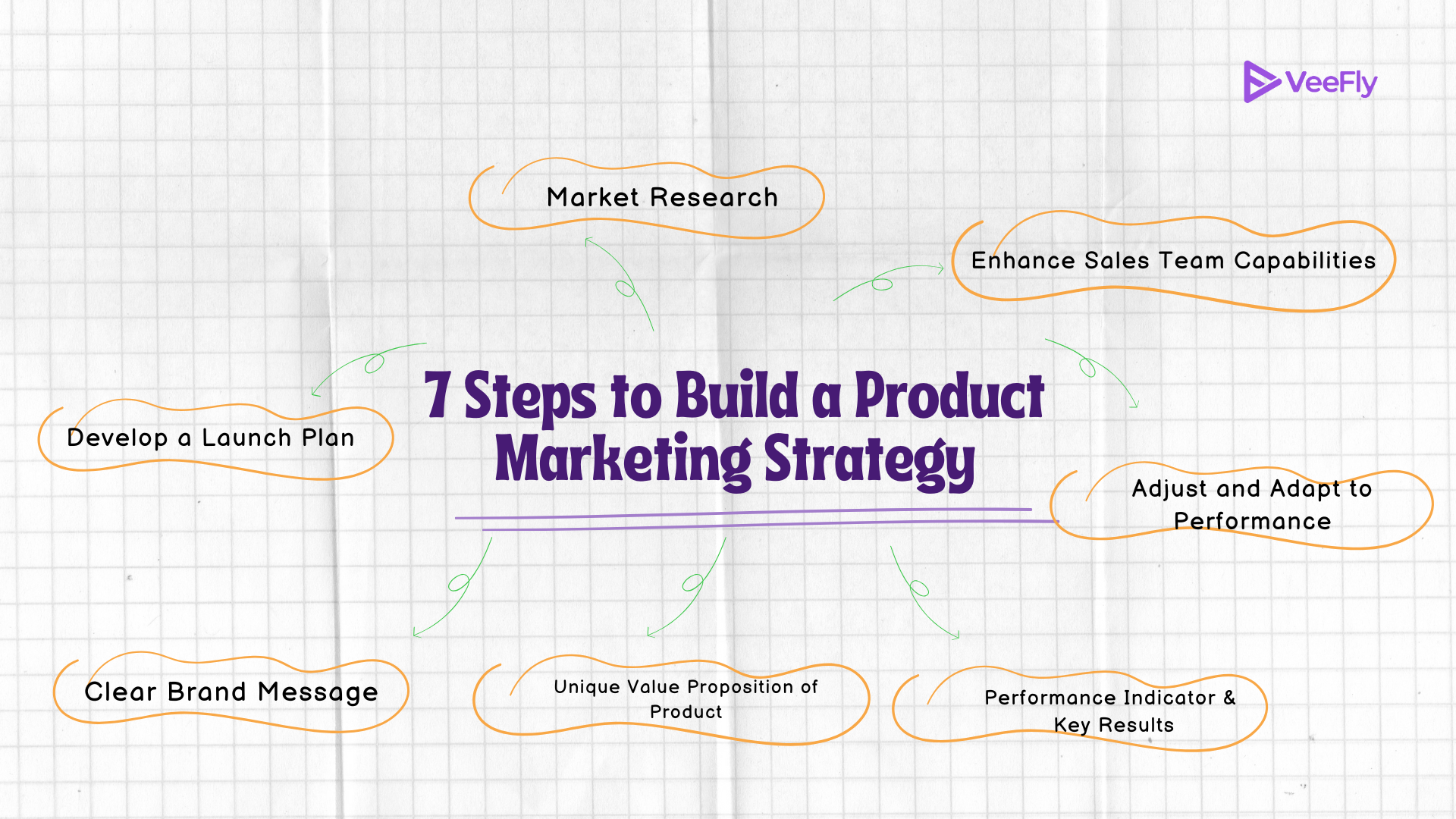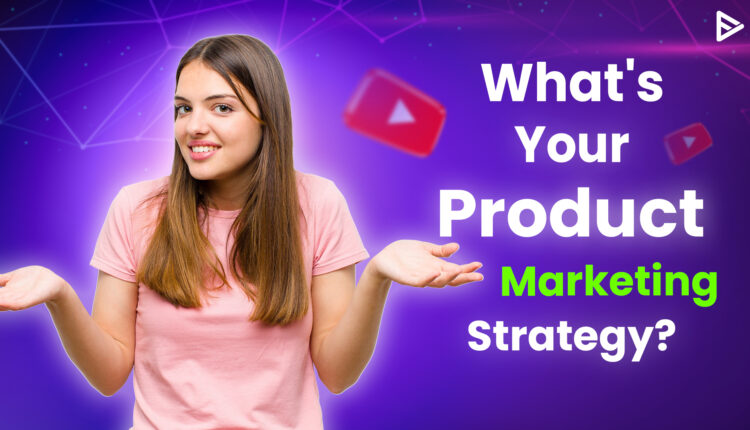Product marketing strategy is basically showcasing your product to the market. While conventional marketing can still get your job done on a larger scale. It is the map to turn your newly introduced product into the most selling product in the market.
Many companies are shifting to product marketing as it is more profitable. So let’s start with understanding a product marketing strategy and why marketing is essential.
What is Product Marketing Strategy?
To give an analogy to product marketing, it is a bridge that connects the customer and the product. However, the strategy is complex; it involves creating a product for consumers, promoting the product, and planning to execute the sale in the market.
Basically, it involves the whole process from development to the launch of the product. There are many products and competitors, but what makes the difference in their business is execution.
The three elements of a product marketing strategy are marketing, sales, and product. Let’s examine each in detail:
The Market: Understanding the market and the customer’s pain points is key. You must determine who you are targeting, their problems, the solutions, and how the solutions will be provided.
The Product: Positioning a product in a well-analyzed market makes it effective. It is easy to set a narrative about how the product is different and better. Emphasizing the product’s value is essential.
The Strategy: It’s time to introduce the product. The strategy involves launching the product using a campaign that sets the narrative, makes consumers understand the product value, makes the sales reach higher numbers, and places products at the right time.
Bonus Tip
The material: The sales team needs tools, information, a sales deck, demos, product details, buyer personas, etc. The higher the quality of this material, the higher the chances of sales.
Why Is Product Marketing Strategy Important?
The first thing you need to remember is the product marketing strategy framework and template. Any strategy can not be implemented without proper guidance for its formation. Next, look at the top tricks that can help you optimize your next marketing strategy.
Find Products Target Audience And Buyer Persona
Creating a buyer persona for your product is a crucial aspect you must keep in mind as a product marketer. Knowing your target audience and the product being sold to them is the first step to creating a successful marketing tactic for your services and products.
Get A Hold Of The Messages Of Your Products
The advantage of performing a consumer analysis is to get a better in-depth idea about the product’s downfalls and strong points. You can also find ways and enhance your development to fit the needs and challenges of your consumers. But, in the end, you need to ensure that you are set standard apart from your competitors. Here is how you can check your product positioning and identify potential gaps.
- Question the uniqueness of your product.
- Figure out why a customer would invest time and money in your service.
- Use action words or a call to action to play human psychology.
- Paying significant attention to your product’s features.
Product Pricing Plays A Major Role In Marketing Strategy
Two kinds of price marketing take place in the market. Namely, competitive and value-based pricing. If you are marketing your product, you also need to focus on the price of the product.
- Competitive pricing is where you choose your price regarding the competitors. You might want to experiment with the costs to get better profit and revenue over time.
- Value-based pricing is a method where you can maximize your income. This is suitable when you are sure your product does not have massive competition and can survive easily with inflated price rates.
Setting The Right Goal To Get Product Marketing Strategy Right
Setting your goal is essential for product strategy for trade purposes. Here is all you need to know:
- Increase revenue
- Engage with customers
- Improve market share
- Gain customers from competitors
- Boost brand recognition
7 Steps to Build a Product Marketing Strategy

Let’s look at seven steps that are needed to sell a product.
1. Market Research
The team should understand their market. The strategy should cover researching the target audience, competitor analysis, trend shifts, and consumer pain points.
Analyze the market gap. Look for ways to solve the problem. Use surveys, interviews, and data to clearly understand consumer needs. In the modern-day market, data is new gold.
The data tells exactly what the customers will need, in what direction the trend is flowing and the new products can be launched when the time comes.
2. Performance Indicator and Key Results
Set key performance indicators and clear objectives. Break down the product strategy into micro goals. These will make the project understandable and allow more room to analyze progress.
The Key Performance Indicators(KPIs) and objectives key results (OKRs) are small micro goals that teams try to achieve within a set time frame.
These small tasks set a clear vision of successful progress. It’s easy to measure and manage things that go wrong. The OKRs method is used by almost every company, especially coming into the limelight when Google adopted it in 1999.
3. Unique Value Proposition of Product
Every consumer looks for unique features. The features should be distinguishable from existing products and so different that consumers can’t even resonate with them.
The unique value proposition is something that the product offers that is not available from competitors. This is what makes the customer choose your product over others.
Finding a USP is a blend of things. It involves what consumers want, what your competitors do great, and what you do great. Let’s look at what you need to provide:
- The product should be relevant to consumers’ problems.
- Extract measurable or achievable data.
- What product does your customer need that is available from competitors?
4. Craft a Clear Brand Message
Now that you have found the unique value proposition, it’s time to position that value to the right audience. The product message should define what’s new the product has to offer. That’s how you will occupy the market.
To create a brand message, first understand the difference between your product value and your competitor’s. Second, define how you want your customers to perceive you. For example, you may want your product to be budget-friendly or premium.
Your messaging should include your UVP, pain points, simple, clear, and direct messaging.
5. Develop a Launch Plan
As we have seen, the execution makes the difference. The KPIs and OKRs set a coordinated process that helps introduce the product with maximum impact.
Identify the channel for reaching the audience. Choose platforms like social media, email marketing software, content marketing, and webinars.
Choose a strategy for organic posts and paid ads, and deliver the brand message. Set a clear message, use a teaser and product release updates, and hype up the release date.
Monitor the process using analytics tools. Adjust the strategies according to the plan. If the plan is working, gradually adapt it to scale it up. If not, look for feedback, issues, and opportunities to get back on track.
6. Enhance Sales Team Capabilities
Look for every opportunity to leverage the sales team’s ability to sell the product. Provide the team with a buyer persona, documents, a product demo, an objection-handling guide, and case studies.
Indulge the team in a robust training session. Prepare them for the worst. Make them confident in the product. Making a better sales team will increase the chances of sales.
Explain to the sales team every intricate detail, such as new updates, feedback, competitive advantage, or any relevant information.
7. Adjust and Adapt to Performance
Effective monitoring of sales, social campaigns, promotions, and consumer acquisition is essential. After the launch, the data will help define the direction of the product’s success.
For example, how effectively are the sales targets achieved? How is the product performing in the market? Compare the product with the competitor’s campaign. At last, the ROI on campaigns.
Analyze the underperforming metrics and adjust accordingly. Look for performing and how it can be effectively utilized in favour.
Conclusion
That’s all you need to know about how to use a product marketing strategy. If you are a beginner, marketing strategy is wholly based on how well you meet your customer’s needs. You will need to work hard in the early stages of the system, which is during your production process. But once your product hits the market, it is smooth sailing. All you need to do is maintain your position in the market and keep placing your product in the right direction.
So, do not give up if you are still stuck on stage one of your product marketing strategy. Just keep going, and one day your business can become a monopoly in the market.
Frequently Asked Questions
Q1. What are the 5 P’s of Product Marketing?
The 5 P’s are product, price, place, promotion, and people. These are the foundational framework of the marketing matrix.
Q2. How Do You Develop A Product Marketing Strategy?
Here are your steps to develop your marketing strategy in the market:
- Analyze your product and your market.
- Characterize your target audience.
- Strong production positioning.
- Set short-term objectives and long-term goals.
- Be with your team.
- Set the correct price for your product.
Q3. What Are The Crucial Elements Of Product Marketing?
Here are the critical elements of product marketing that you should know:
- Segmentation
- Target and position
- Promotion Tactics
- Evaluation
- Production
Q4. What Is The Best Product Marketing Strategy In The Market?
One promotion strategy you can use is to offer discounts on your products. This can help loyal customers return and provide new customers to engage with your brand and product.


